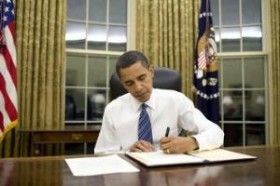The Obama administration released its Fiscal Year 2014 budget proposal Wednesday, including its 2014 federal drug budget. Pundits and politicians on both sides of the aisle quickly pronounced the Obama budget dead on arrival, but it does provide both a window into administration thinking on drug policy and a starting point for negotiations.

Obama’s 2014 drug budget came out Wednesday. (whitehouse.gov)
There’s not much new. The historic 2:1 ratio between law enforcement and interdiction spending and treatment and prevention spending, representing what critics have long called an over-reliance on enforcement, is slightly attenuated. The Obama 2014 drug budget allocates 58% of spending to enforcement vs. 42% to treatment and prevention. It is a slight improvement over the FY 2013 drug budget, where the figures were 62% and 38% — starting to climb away from 2:1, if it continues, but not dramatically.
In a post on its web site, the Office of National Drug Control Policy’s Rafael Lemaitre writes that treatment and prevention spending now tops domestic law enforcement spending, and “that’s what a 21st Century approach to drug policy looks like,” but that post does not include interdiction and international drug enforcement spending. When those are included, the Obama drug budget is clearly weighted on the side of law enforcement — very much what a late 20th Century drug policy looked like.
Still, the budget calls for an 18% increase in treatment funding, and cuts in interdiction and international enforcement funding, as welling as reducing funding for the High Intensity Drug Trafficking Area (HIDTA) program, which generates ever more drug arrests working with state and local drug task forces. But spending for both the DEA and Bureau of Prisons is going up, and that raised the hackles of one drug reform activist.
“The administration deserves some credit for moving this ratio slightly in the right direction over the years, but a drug control budget that increases funding for the DEA and the Bureau of Prisons is simply not the kind of strategy we need in the 21st Century,” said Tom Angell, spokesman for the Marijuana Majority. “At a time when a majority of Americans support legalizing marijuana, and states are moving to end prohibition, this president should be spending less of our money paying narcs to send people to prison, not more. If, as administration officials say, ‘we can’t arrest our way out of the drug problem,’ then why are they continuing to devote so many resources to arresting people for drug problems?”
The administration also deserves “some credit” for reducing HIDTA funding, said Angell, but “still $193 million for the program is $193 million more than should be used to arrest people for drugs in the 21st Century.”
Article republished from Stop the Drug War under Creative Commons Licensing









